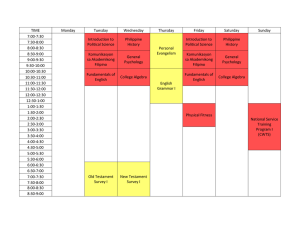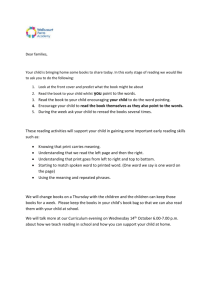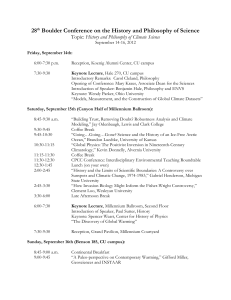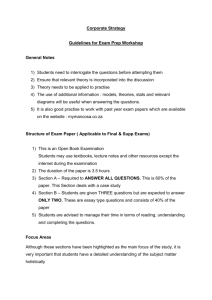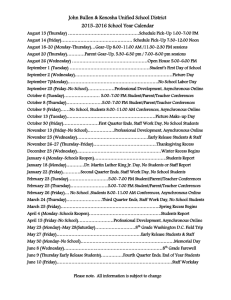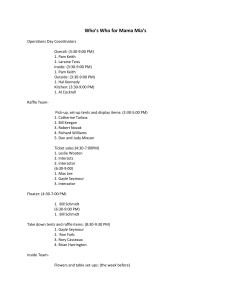Executive Policies and Planning 67058
advertisement
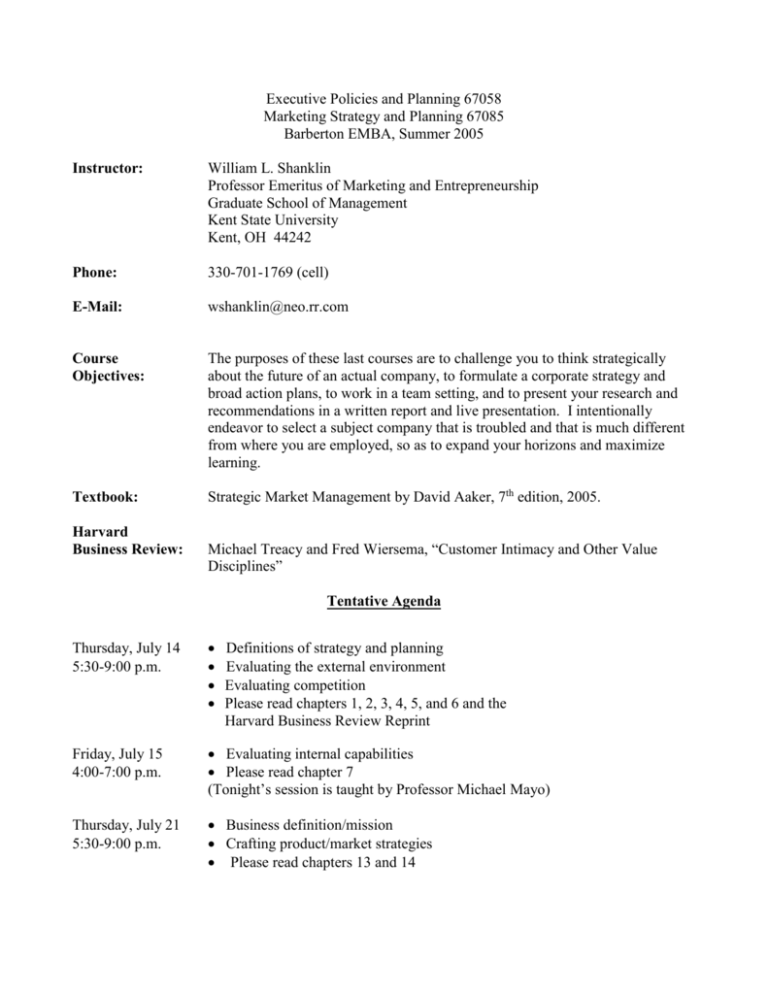
Executive Policies and Planning 67058 Marketing Strategy and Planning 67085 Barberton EMBA, Summer 2005 Instructor: William L. Shanklin Professor Emeritus of Marketing and Entrepreneurship Graduate School of Management Kent State University Kent, OH 44242 Phone: 330-701-1769 (cell) E-Mail: wshanklin@neo.rr.com Course Objectives: The purposes of these last courses are to challenge you to think strategically about the future of an actual company, to formulate a corporate strategy and broad action plans, to work in a team setting, and to present your research and recommendations in a written report and live presentation. I intentionally endeavor to select a subject company that is troubled and that is much different from where you are employed, so as to expand your horizons and maximize learning. Textbook: Strategic Market Management by David Aaker, 7th edition, 2005. Harvard Business Review: Michael Treacy and Fred Wiersema, “Customer Intimacy and Other Value Disciplines” Tentative Agenda Thursday, July 14 5:30-9:00 p.m. Friday, July 15 4:00-7:00 p.m. Evaluating internal capabilities Please read chapter 7 (Tonight’s session is taught by Professor Michael Mayo) Thursday, July 21 5:30-9:00 p.m. Business definition/mission Crafting product/market strategies Please read chapters 13 and 14 Definitions of strategy and planning Evaluating the external environment Evaluating competition Please read chapters 1, 2, 3, 4, 5, and 6 and the Harvard Business Review Reprint Friday, July 22 4:00-7:00 p.m. Continued from last session Thursday, July 28 5:30-9:00 p.m. Strategic approaches to markets Importance of market share Experience curves and economies of scale Strategies in mature and declining markets Please read chapter 15 Friday, July 29 4:00-7:00 p.m. Strategies in emerging markets No assigned reading Thursday, August 4 5:30-9:00 p.m. Strategies in emerging markets continued Strategic positioning: crafting a sustainable competitive advantage Please read chapter 12 Friday, August 5 4:00-7:00 p.m. Examination (if applicable) Individual consultations with teams Teams work on report Thursday, August 11 5:30-9:00 p.m. Presentations: Group 1: Group 2: Group 3: Group 4: Group 5: 5:30-6:05 p.m. 6:10-6:45 p.m. 6:50-7:25 p.m. 7:30-8:05 p.m. 8:10-8:45 p.m. *The dress protocol for the presentations is business formal. Grading Options Option 1 Examination Written consulting report + presentation 50% 50% Option 2 Written consulting report + presentation 100% Each person has the option to write an examination if he or she does not want the course grade determined entirely by the group report; you must let me know by July 29 if you want to take an examination. I also reserve the right to have the entire class write an examination, and whether I give an exam to everyone or not depends on the quality of overall class participation. I will have each of you evaluate your peers in your group. You cannot assume that you will automatically receive the same grade as the overall group grade. I will make adjustments for lack of participation or inadequate effort, if necessary. Your final grades for Executive Policies and Planning and Marketing Strategy and Planning may or may not be identical. After evaluating your report and presentation, I may conclude, for example, that you earned an A+ and therefore should received a letter grade of A for both courses. By contrast, I may conclude that you have a borderline A/B or B/C report and presentation and thus I would be likely to assign different grades in the two courses. You will be asked to designate in which course you would prefer to receive the higher grade, if that becomes necessary. Assignment My objective is to give you a challenge that will require you to think strategically and to integrate what you have learned in the EMBA program—and then some. Accordingly, your task is to develop a strategy—and the major tactics to implement it—to revitalize Krispy Kreme Doughnuts, Inc, which trades on the NYSE under the symbol KKD. Prior to the start of class meetings, you should collect information you will need to do a situation/SWOT analysis and also you need to begin to formulate your thinking on a grand strategy and major tactics to turn this company around. You can find 10K forms at SEC.gov and obtain an annual report and other investment information at krispykreme.com. By the initial class meeting you should have outlined the strengths, weaknesses, opportunities, and threats facing Krispy Kreme. Strengths and weakenesses are internal to the company---and therefore controllable—and opportunities and threats are external to the company, and thus largely uncontrollable. Please form five teams to work on the project (no more than six people in a group). Each team should have complementary skills (rather than redundant skills), such as finance, marketing, and operations. As soon as you have a team, e-mail the names to me. Thank you. Term Report Format 1. Cover Page. Make it a professional cover page from a consulting group rather than an academic cover page for a course. 2. Table of Contents with Page Numbers. 3. Executive Summary. This section is written last, yet is the first read. In fact, it may be the only section read by top management in large companies with many business units. The executive summary is a stand-alone abstract of your entire analysis. It is 2-3 typewritten pages and should be physically detachable (i.e., it can be separated from the rest of the report). A top executive should be able to read this section only and get a clear grasp of the entire report. After you prepare the executive summary, have someone read it. Does your abstract convey to this person a basic understanding of the situation, the issues and alternatives facing management, and the recommended solutions? 4. Situation Analysis. This component normally identifies what present environment and what most likely future environment the company faces. A SWOT analysis of strengths, weaknesses, opportunities and treats is an efficient way to conduct a situation analysis. Begin with a narrative concerning the relevant environmental factors (economic situation, competition, demographic, technology, financial position of the subject company, etc.) and end by itemizing SWOT in a summary table. 5. Identification and Discussion of Problems and Issues. Designate and describe what you believe are the major problems and/or issues and support your assertions. 6. Mission Statement. Produce a concise corporate mission statement (i.e., business definition) and explain why it is strategically appropriate for the next 1-5 years. 7. Objectives and Goals List and explain objectives and goals for the next 1-5 years. 8. Corporate Strategy. Delineate a statement of corporate strategy for the next 1-5 years in three pages or less. 9. Action Plans. Provide an overview of tactics (specifics) for implementing the strategy with approximate timelines. 10. Appendices. Place supporting materials in appendices. 11. End Notes and Bibliography. Use any well-known style manual >>The reports will not be returned. However, you will each receive a grading sheet with my evaluation of your report.
